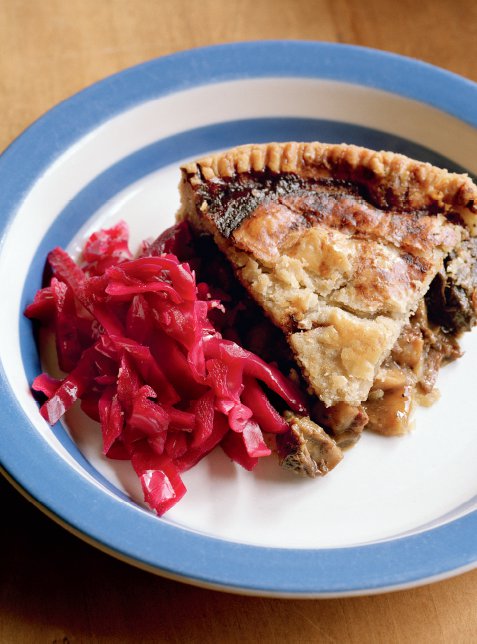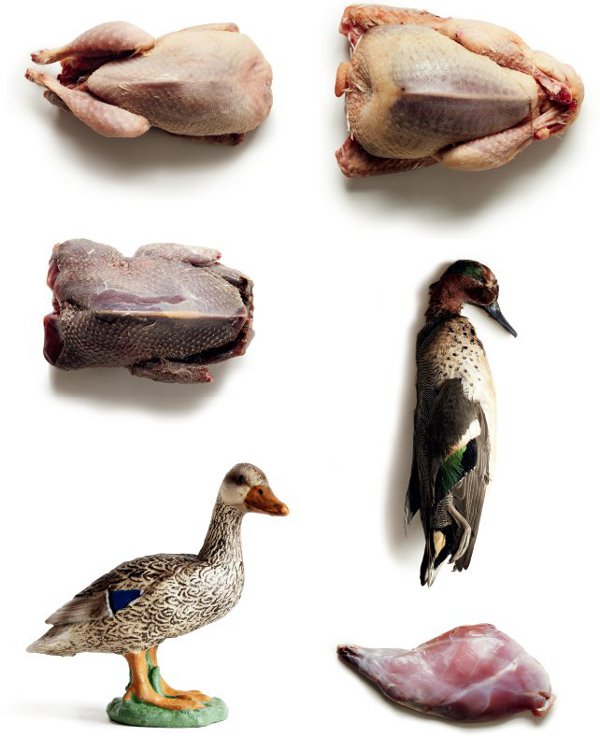Good Cook (15 page)
Authors: Simon Hopkinson

serves 2
2 tbsp butter
2 tbsp olive oil
salt and freshly ground black pepper
4 chunky pieces of pork shin (osso buco), approx. 1¾–1
7
/
8
lb
a little flour
1 onion, finely chopped
at least ½ a bottle of drinkable, dry white wine
a touch of lemon juice
2–3 sprigs of sage
for the saffron mashed potatoes
1¾ lb floury potatoes, peeled and cut into chunks
1 tsp saffron threads
1 clove of garlic, peeled and crushed to a paste with a little salt
3 oz milk
3–4 oz extra virgin olive oil
for the gremolata
zest from ½ a small orange, in strips
a small handful of parsley sprigs
1 small clove of garlic, peeled and bruised
I am very pleased with the idea for this recipe, as it includes a favorite cut of meat married to a special dish of mine, that of mashed potatoes flavored with saffron. For those who are familiar with the great Milanese dish of Osso buco alla Milanese (slowly braised veal shin served with saffron risotto), the answer lies there. So I was especially thrilled to find freshly prepared, chunky slices of pork shin in the butchery department of my local supermarket one day and the idea began to grow. Also, the notion of a gremolata with orange zest instead of the more familiar lemon is an unusually fragrant addition.
The care involved in the cooking of this dish is, essentially, a labour of love. The following method is one of my most favorite of all Italian braises, and is based upon the preparation known as “in bianco.” This is simply onions and white wine, with definitely no tomato. The meat is lightly floured, nicely colored in a mixture of olive oil and butter, the excess fat tipped away and wine intermittently introduced over a slow and gentle heat, until the juices are syrupy and well flavored.
Melt the butter and olive oil in a heavy-based deep pot—of a size that will hold the pieces of meat in a single layer—and heat the fats until they are beginning to froth. Season the pork pieces and dip lightly into the flour. Shake off any excess and put them into the pan. Fry on both sides, until each surface is crusted and golden brown. Remove the pork to a plate and tip out all but a spoonful of fat. Add the onion to the pot, quietly stew these until well colored, then return the pork to the pot.
Reduce the heat and pour in a glass of wine. Allow to bubble up and turn down the heat even further. Partially cover the pan and simmer so gently that the liquid merely shudders from time to time. Turn the meat over once the wine has reduced somewhat and add a little more wine, along with the lemon juice and sage. Cover and braise for a further 30 minutes. Check occasionally that the wine has not evaporated too much. If so, again, add some more wine. The total cooking time should not be much longer than 1½ hours. Eventually, the winey gravy should only just be enough to sauce the meat; say a couple of tablespoons for each serving. Keep the pork warm, covered.
Meanwhile, boil the potatoes in lightly salted water until tender. Warm together the saffron, garlic, milk and olive oil in a small pan. Cover and infuse for 10 minutes. Drain the potatoes well; dry out in the oven if they seem excessively wet. Pass the potatoes through a potato ricer into a heated bowl, then add the saffron mixture in a thin stream, beating energetically with a wooden spoon; don’t use a whisk, as the saffron stamens will become all entangled in it. When all the saffron infusion has been added, continue to beat and lighten it.
When ready to serve the dish, quickly make the gremolata. Simply put the orange strips, parsley and garlic together on a board and, using a sharp, heavy knife, chop them together until fine. Reheat the pork, fish out the sage and discard, then transfer 2 pieces of pork to 2 hot plates, together with their gravy. Spoon some of the saffron mashed potatoes alongside and, finally, sprinkle some of the gremolata over the meat. A complete dish, with deeply savory qualities.
serves 2, generously, as a main course
for the lentils
3 tbsp olive oil
1 small onion, finely chopped
2 cloves of garlic, finely chopped
4½ oz lentils, Italian Castellucio, French Puy, or other
1 bay leaf
freshly ground black pepper
salt
a small slice of butter
2 tsp smooth Dijon mustard
a trickle of red wine vinegar
1 pre-cooked cotechino sausage (see below), heated according to instructions
to serve
mustard fruits (mostarda di Cremona, see below)
An Italian cotechino sausage, pre-prepared, foil-packed and cooked in its own fat and juices, is a marvelous, almost instant meal—and taken directly from the store cupboard whenever you fancy it. I, for one, am rarely without a cotechino at hand.
They are readily available from good Italian delis, packed in handsome boxes, and offer a generous shelf life. You should not, at all, ever feel guilty about this most useful of “ready meals.” They are incredibly tasty, highly seasoned and with a rich flavor. If you have never eaten one, I urge you to search them out.
Conveniently, similar provenders will also stock jars of sticky “mostarda di Cremona” (the northern Italian city where it originates). This sweet and “hot” conserve consists of preserved fruits—cherries, peaches, melon rind, pears—soaked in a sweet syrup infused with pungent mustard oil. Some brands are hotter then others, but the most common I have seen in the UK is Sperlari, available online.
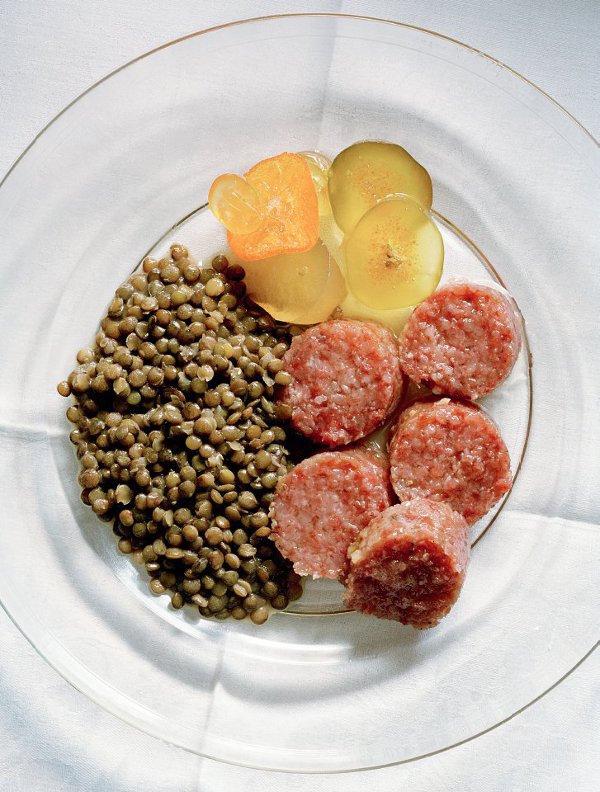
However, the finest mostarda I have ever purchased was in the fabulous food store Peck, in Milan. Stock up there if you ever visit that city. Furthermore, if you want the treat of your life, gourmet-wise, Peck is the finest food emporium I know, anywhere.
Heat the olive oil in a stainless steel or other non-reactive saucepan and fry the onion and garlic until soft. Add the lentils and stir so that they are well coated and glisten. Cover with water by about 5cm, pop in the bay leaf and grind in plenty of pepper; do not add any salt now, as it has a tendency to harden the lentils while they cook (if you need any extra water, add it from a boiled kettle). Gently simmer the lentils, uncovered, for 30–40 minutes or so, until they are just cooked and most of the water has been absorbed. Remove the bay leaf and, only now, season with salt to taste. Stir in the butter, mustard and vinegar. Keep the lentils hot, covered.
Remove the cotechino from its cooking packet, stir any juices into the lentils, and serve them both piping hot, the sausage thickly sliced, and with some of the mustard fruits, roughly sliced, as a deliciously sweet and pungent condiment.
serves 2
1 small lemon, cut into quarters
4 quails
salt and freshly ground white pepper
4 tbsp cold butter, diced
7 oz verjuice
2–3 tbsp chicken stock
20 seedless grapes, peeled, if it pleases …
Some folk don’t get quails and I have never understood quite why. They taste very good indeed when carefully cooked. The finest ones that I have ever eaten (about twenty years ago, now) emerged from a revolving spit, within an enormous fireplace and cooked over an enormous log fire by our host Helen Hamlyn (widow of my partner at Bibendum, then, the late Paul Hamlyn), in their house in Gloucestershire. In fact, not only were they the best quails I have ever eaten, I am not so sure they were not one of the most delicious plates of food full stop. I guess, however, that they were made even more memorable by a lump of black truffle wrapped in a slice of fatty bacon, that had been pushed inside them while they cranked away, before being done to a turn, as they turned on the spit …
Here, they are more prosaically pot-roasted with verjuice and grapes, but are none the worse for that; one would not wish to diminish my diminutive birds simply because they don’t have a lovely truffle up their bottom. Verjuice is an acidic juice made from the pressing of unripe grapes, then bottled. The maker of this cooking condiment that has most pleased me in the past is one made by Australian Maggie Beer.
Note: if you can find them, large, well-fed French quails will appeal more than the smaller, less plump British birds.
Preheat the oven to 400°F.
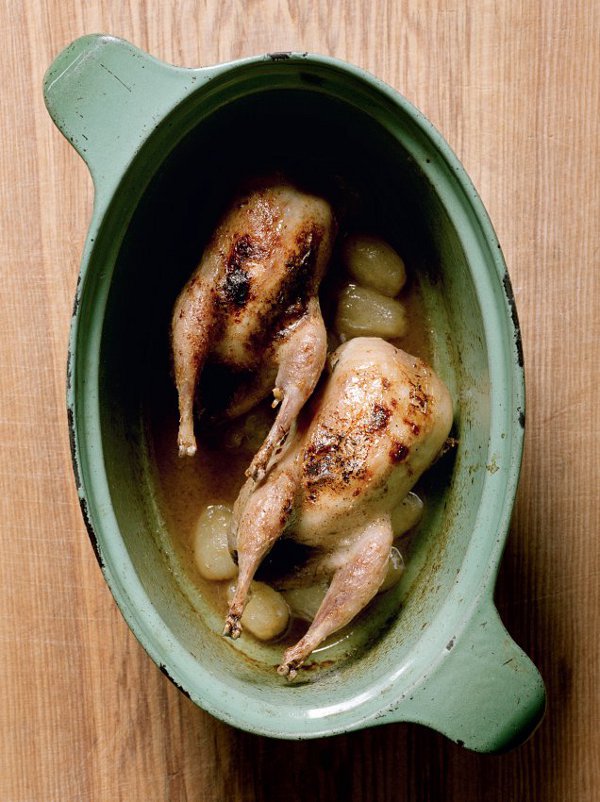
Squeeze a little lemon juice over the quails, then put a lemon quarter into the cavity of each one. Season with salt and pepper. Melt about 2 tbsp of the butter in a frying pan and brown the little birds gently on all sides until golden—about 5 minutes. Arrange them in a deep, lidded and heavy-based pot, pour in the verjuice and bake in the oven for 10 minutes, covered. Remove from the oven, turn the quails over, and cook for another 10 minutes. Turn off the oven, lift out the quails from the pot and keep warm in the waning heat of the oven, its door ajar.
Place the pot on a moderate heat, add the stock and grapes and cook until the sauce is reduced by half—or, at least, until beginning to turn a touch syrupy. Swirl in the remaining diced, cold butter to finish the sauce. Check for seasoning, pour the sauce over the quails and serve immediately, with creamed potatoes, I think.
Note: if you like, extract the lemon quarters from inside the quails and squash them into the sauce as you eat, for a sharper finish to the dish.
serves 4
2 tbsp butter
6 oz piece of fatty, streaky bacon, cubed
salt and freshly ground black pepper
2 oven-ready wood pigeons or Cornish hens
7 oz dark-gilled, open-cup or other mushrooms, quartered
1 large carrot, cut into thick slices
1 small onion, quartered
1 stick of celery, cut into short lengths
2 tbsp Cognac
9 oz red wine
10 oz chicken stock
3 cloves
1 bay leaf
6 juniper berries, bruised
1 heaped tsp redcurrant jelly
1 rounded tbsp flour
for the pastry
4½ tbsp butter
4½ tbsp lard
1
1
/
3
cups self-raising flour
pinch of salt
2–3 tbsp ice-cold water
1 egg, beaten
Now that I reconsider this pie, so relentlessly cooked, tested and most pleasurably scoffed, it occurs to me that it is, in fact, wood pigeons cooked in the style of a coq au vin, taken off the bone and put into a pie. Maybe not the most original of notions, but pastry and red wine pigeon gravy seems to be no bad thing, especially with that gorgeous gooey bit underneath the crust which is sogged by that particular gravy.
Note: you will need to cook the pigeon pie filling and allow it to cool, at least 4 hours before you assemble the pie; in fact, if you can, cook it the day before and store it, covered, in the fridge.
Preheat the oven to 275°F.
Melt the butter in a large, heavy-based, lidded pot and in it quietly fry the bacon until crisp. Lift it out with a slotted spoon and put on a plate. Season the pigeons and slowly brown all over in the resultant bacon fat for several minutes, then remove and place alongside the bacon. Now tip in the mushrooms and fry them, too, until well colored. Also remove these and add to the pigeons and bacon. Add the carrot, onion and celery to the pot and fry them briskly in any remaining fat (add a touch more butter, if necessary) until slightly browned, before returning only the pigeons to the pot. Spoon over the Cognac, ignite it, then pour in the red wine and stock. Add the cloves, bay leaf, juniper and redcurrant jelly. Bring up to a simmer, put on the lid and braise in the oven for 1½ hours.
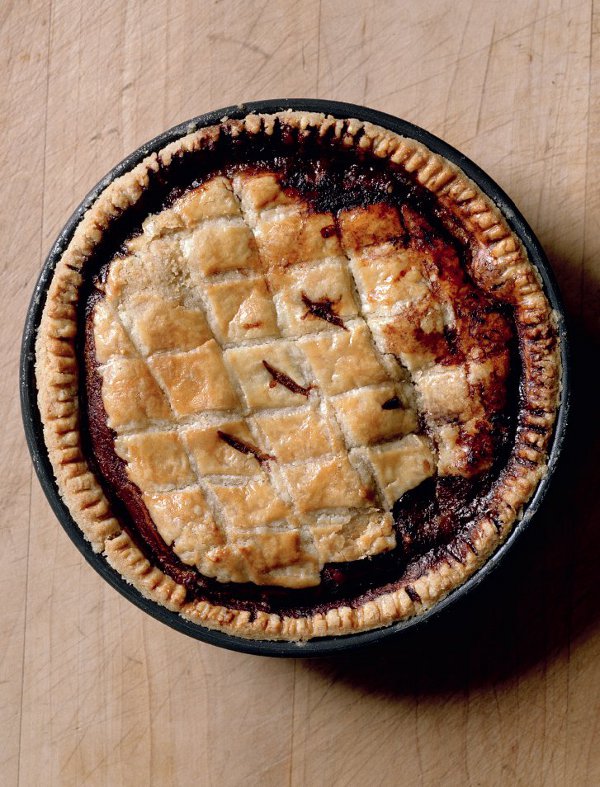
Lift out the pigeons, which will be good and tender, and carefully place back with the bacon and mushrooms. Strain the braising stock through a sieve suspended over a large saucepan, press the vegetable debris with a ladle to extract all flavor, then discard it. Now then, unorthodox as this may sound, sprinkle the flour over the surface of the stock—which will have a thin surface of fat upon it to absorb the flour—and vigorously whisk it in until dissolved. Bring this up to a simmer and allow to cook, quietly, for 10–15 minutes. Remove every scrap of meat fromthe pigeon carcasses and add to the thickened stock. Tip in the reserved cooked mushrooms and bacon, mix in well, and continue cooking what has now become the pigeon pie filling, for a further half an hour. Tip into a bowl, leave to cool, then cover with plastic wrap and put into the fridge for at least 4 hours, or overnight.
To make the pastry, cut the butter and lard into small chunks and place in a large bowl with the flour and salt. Gently rub the fat into the flour, using fingertips, until the texture resembles very coarse breadcrumbs. Mix in only just enough water to bind the mixture together. Lightly knead this dough until well combined, dust with flour and slip into a plastic bag. Place in the fridge for 30 minutes before using.
Preheat the oven to 350°F and also place a flat baking sheet in there, which will help to cook the base of the pie more thoroughly. Lightly butter a loose-bottomed tart pan (approx. 8 in wide x 1½ in deep). Roll out two-thirds of the pastry (not too thin) and use it to line the base and sides of the pan. Now roll out the remaining third to a similar thickness, and generously wide enough to use as a lid to the pie, and put to one side. Pile the cold pigeon mixture into the pastry-lined pan and lightly press it down.
Brush the edges of the pastry crust with beaten egg to seal the pastry lid upon it, while also pressing the edges together lightly before trimming off any excess
overhang. Brush the surface of the pie with more beaten egg, make 3 small incisions into the center of the pie using the point of a sharp knife and, if you wish, further decorate the edges of the crust with the tines of a fork.
Bake the pie on the preheated baking tray on the middle shelf of the oven, for about 40–50 minutes or until the surface is a rich, golden brown. Remove from the oven and leave for a good 10 minutes before unmolding and cutting into generous wedges. Eat with buttered Brussels sprouts or pickled red cabbage.
